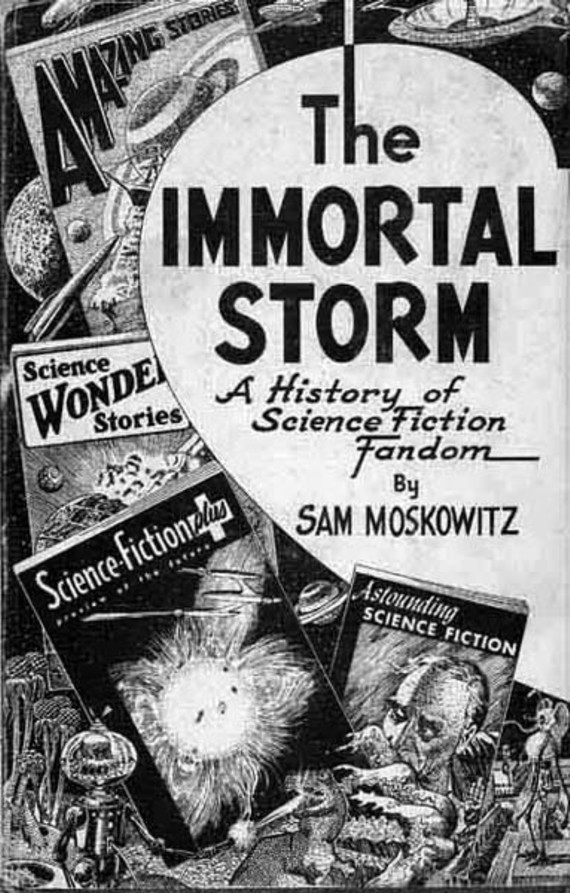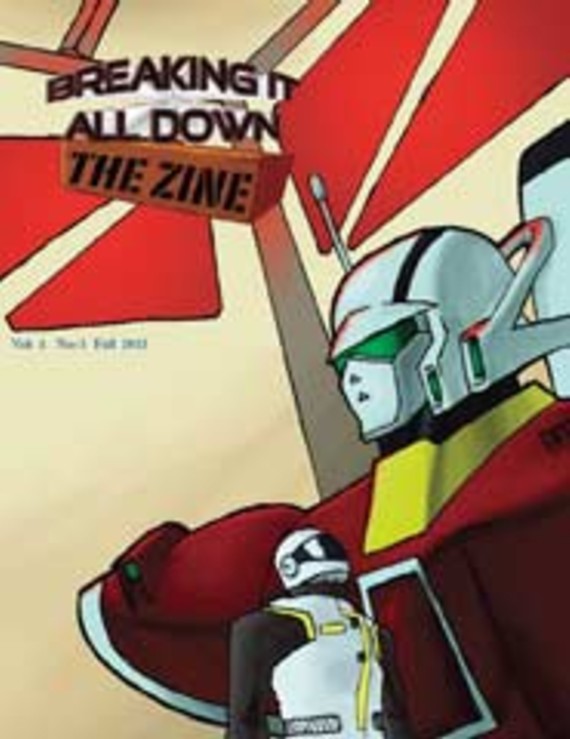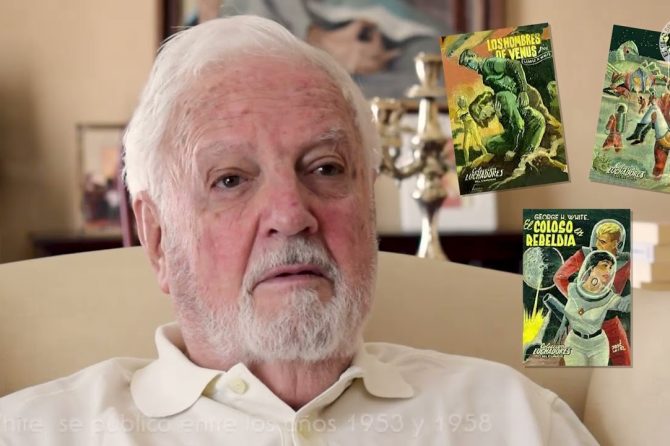
A short while ago someone asked me if I knew Sam Moskowitz. No I didn’t, but I’ve written extensively about him and his famous (at least in science fiction fandom) book, The Immortal Storm.
There’s a simple reason SaM (his fannish nickname and not a typo) used this title for his book on the pre-historic era of fandom (ah…that’s gonna upset a couple of people, probably enough so that this editorial isn’t posted too…oh well). According to both SaM and another fan historian, whom I did know, Jack Speer, the beginnings of fandom were consumed with feuds, bickering, hoaxes, all out wars, and lots of other fun stuff.
And it was fun for most of those that participated.
There was the Staple-Brass Tacks War begun in 1934 by Bob Tucker (better known as science fiction writer Wilson Tucker) that was fought in the pages of the fanzines of that time. The issue was whether to use staples for your printed fanzine or to use brass tacks. I favor staples. Taking a stand will probably upset a lot of people even now, when fandom has converted almost entirely to the web.
Taking a stand even in a nonsense battle over how to bind a fanzine underscores the point, that fandom is made up of an aggregate of individuals. Not conformists. These individuals know a softball when one is pitched at them.

However, The Immortal Storm was written to sum up the stages that led to the first clear grouping of fandom into two segments. Back then the group belonging to the masses was known as New Fandom, a term coined by SaM. The other group was at first known as the Michelist, formed by Don Wollheim and his pals, it was a small group of elitists with only one self-professed goal in mind, to subvert fandom to their own ends and gains.
Many people will compare The Immortal Storm with Jack Speer’s Up To Now or his Fancyclopedia. Perhaps a quote from Speer himself will settle the first: “Ungraciously, I have to register a dissent to F.T. Laney’s opinion that Up To Now was less biased and more accurate in details than The Immortal Storm. As he comes up into events in which he partook, Sam may become guilty of more slanting: but, so far, aside from some scarcely noticeable prejudice for Ackerman, he has remained commendably impartial and the factual research in Storm is out of Up To Now class entirely.” (From a letter in Vampire #8)
The value of this history (The Immortal Storm) to present day fandom is not that it details the doings of a certain group of young people in pre-WWII times but rather in its details of fan magazines, the organization and decline of fan clubs, the deadly and sterile results of feuds, the universality of these problems in fandom. It is, in some ways, amazing to think that so many words are expended upon problems, which a few years can toss into utter oblivion. And when the same problem comes up a few years later, a new generation of fans takes up with fanaticism and vigor the facets of this “crushing” item.
The Immortal Storm as it stands, is incomplete. Ending with the conclusion of the First World Science Fiction Convention in 1939, it does not stop at a natural break, which would be a time when a definite era of fandom was over. Instead it finds a natural stopping point at the formation of the two major segments of contemporary science fiction fandom of our present day. Later fan-historians may well extend the story to December 7, 1941, or even later. Informed fans know what has to come next, the reaction against New Fandom, the second and third conventions, the outbreak of World War II and the virtual collapse of British Fandom, the Cosmic Circle (of the infamous Claude Degler, but more about him later), etc. Whatever point Moskowitz selects there is little doubt that future historians of fandom will use it as a starting point. No one can add more to the territory already covered except the personal memoirs (should they ever be written) of Wollheim, Pohl, Palmer, Ackerman, Lowndes, and a few others of the period.
It is what happened at the First World Science Fiction Convention in 1939 that is of interest, and the thread of this editorial. SaM excluded Don Wollheim and his pals from attending the convention. Wollheim and his pals were well-known communists and had printed up a pamphlet and various flyers, which they were handing out at the convention. The pamphlet was a virulent and scurrilous attack on the convention committee and on the Queens SFL group (hosts of the convention) specifically. A stack containing five different titles containing more Futurian propaganda was found nearby that group, making a lie to Wollheim’s statements that the group was there to have fun in attendance. There was no doubt that they were trying to subvert fandom. These Futurians (a small exclusive club of pros and wannabe pros) had a secret agenda. They finally made it publicly known.
During the lead-up to the convention Wollheim attended planning meetings and read a communist track, “Mutation or Death!” written by fellow Futurian John B. Michel, designed to bend the rest of fandom into that political organization. As another part of the run-up to the convention, Wollheim and the rest of the Michelist faction formed the Futurian Science Literary Society, later known as the Futurians. Their proximate purpose to subvert fandom toward their ends. They clearly thought that they could toss another softball at the mass of fandom and fandom would eat it up because these guys were pros.
Many years later, when Fred Pohl (another Michelist and founding member of the Futurians) wrote his memoirs, he softballed the whole event, according to him they were just good ‘ole boys having a good ‘ole time. They all dropped that Michelist nonsense when they started making big money in science fiction. It seems they did in the long run achieve one of their main goals, to bend the masses to their own ends and needs, substituting a (communist) political one for a (capitalist) money-making one.
It’s funny how trying to make money changes people, and how easily they change one set of principles for another more convenient set. Ah, there’s nothing like the complete and utter lack of integrity. Most people nowadays would be tremendously surprised to find that their heroes, guys like Pohl and Wollheim, were ardent communists in their youth. They would certainly be upset with me for pointing it out, even though SaM wrote The Immortal Storm (thus his title) documenting those times so that there would never be any doubt.
But facts can be inconvenient truths.
So, now to this weeks electronic fanzines as found at Bill Burns’ website eFanzines.com.
***

It seems appropriate to being with The Emphatic Route, a fanzine edited by Guy and Rosy Lillian, the latest in their ongoing series of con reports, this one “Being a report on the journey of Guy and Rose-Marie Lillian to the city of San Antonio, Texas and the 2013 World Science Fiction Convention through words and photographs for the Southern Fandom Press Alliance and eFanzines.com.” Whew! That’s a lot, and they deliver it too. They kick off their report with a mention of making friends with TAFF delegate Jim Mowatt. The TransAtlantic Fan Fund (TAFF) was created in 1953 for the purpose of providing funds to bring well-known and popular science fiction fans across the Pond. Long-time fan Shelby Vick initiated the concept with his “WAW with the Crew in ‘52” campaign, an attempt to bring over British fan Walt Willis. You really must read this fanzine. I was tickled to see the following: “So the Worldcon not only has little appeal for the young, it has little to attract new fans. It is what it is. It’s for who it’s for. Such is the nature of this era in the life of science fiction fandom. Whatever there is to Worldcon, newness is not it.” Spot on, and in agreement with my editorial. This fanzine drips with the trenchant wit of the editors. It is not for the easily upset. It is filled with constant revelations about the current state of fandom, from someone well entrenched in it. Well, I won’t say more, except to highly recommend this enlightened and enlightening, as well as highly entertaining, zine. It has photos too….
***

The Reluctant Famulus #95: September/October 2013. Bi-monthly. 58 pages, edited by Thomas D. Sadler. Brilliant cover art by T.D.S. Contains an “Introduction” by the editor. Sadler begins by coining a new word, pareidoliagists. While not as easily understandable as one of the famous ones produced by fan Rick Sneary (The Great Illittérateur), it becomes apparent from the context of this article about UFOs and other oddities. “Rat Stew,” by Gene Stewart, is another article in keeping with this weeks’ theme, the individual in fandom. Stewart gives with a fine article about fans abilities to think for themselves, and how they dislike being pandered to. He tells us: “Say you like to read or even write science fiction. How would you feel if all science fiction were judged by the least literate fanfic and no one ever saw any better examples…” This article is filled with contemporary insights into the inner workings of the mind of one of today’s fans. “Global Warming,” by Alexis Gilliland. This essay is in the style of an interview between Gilliland and Morrie the Critic. In keeping with the topic of this zine for this issue, it is another insightful look into the real world of man-made climate change. No softball tossed here. In “Ruminations,” by Dalmer Shasto, a newcomer with his first article, he delivers a dilly. An in-depth look at the evolution of religious communes, complete with photographs and genealogical details. While not technically about science fiction or fantasy, in “Kentuckiana,” by Al Byrd, the writer manages to produce a very interesting related story about such during the American Civil War. A must read for enthusiasts of that era. “Star Rover,” by Eric Barraclough, brings us back to fandom with a brief review of the book by this title written by Jack London, and a longer look at the life and times of the man. Next is “In My Spare Time,” by Aldo H. Masters. At first glance, the careless reader might pass by this article about gardening until Masters recounts the chilling and freakish results. “D.D. Ferguson, part II,” by Matt Howard, is another side step, and well worth taking, about this relatively unknown rock’n’roll legend. “The Crotchety Critic,” by Michaele Jordan, is a book review column. I won’t spoil the fun, read it and find out for your self. And “Letters,” this zines letter column. By the list of locs, this is a very well-known and commented to zine. There are some notable highlights such as the letter from Joseph T. Major, and the ubiquitous Lloyd Penney.
***
 The Drink Tank #357: October 2013. Weekly. 10-pages. Edited by Chris Garcia. This issue kicks off with “Three Ambulances for a Dollar,” by James Bacon. The subject of my editorial seems to be on the topic of the day. Bacon begins his article with: “America sorta confounds me. It is the most incredible place, but it is America, and is very hewn to the capitalist ideal and therefore everything is really about money.” Need I continue? Essentially his article is a call for EMTs to be in place at conventions. Not a bad idea. Continuing in this vein, James Fedora gives more “On Operation Hammond,” about this social medical organization. Chris Garcia continues with this issues theme with “On Cons and Emergency Medical.” These guys raise a great point.
The Drink Tank #357: October 2013. Weekly. 10-pages. Edited by Chris Garcia. This issue kicks off with “Three Ambulances for a Dollar,” by James Bacon. The subject of my editorial seems to be on the topic of the day. Bacon begins his article with: “America sorta confounds me. It is the most incredible place, but it is America, and is very hewn to the capitalist ideal and therefore everything is really about money.” Need I continue? Essentially his article is a call for EMTs to be in place at conventions. Not a bad idea. Continuing in this vein, James Fedora gives more “On Operation Hammond,” about this social medical organization. Chris Garcia continues with this issues theme with “On Cons and Emergency Medical.” These guys raise a great point.
***

The Drink Tank #358: Another weekly issue for October 2013, as edited by Chris Garcia. 16-pages. Chris begins with “Letter Graded Mail” which will produce an instant chuckle with: “And we begin, as many issue have, with a letter from Mr. Lloyd Penney!!!!!” I had to count the five exclamation points to be sure I got all of them. Lloyd delivers an insightful look at the current state of fan Hugo Awards, who gets ‘em and how. Chris follows with an article, “The Jerk Writer Stages of Grief.” This is no softball article for the easily upset. Chris gives with a candid discussion of as he puts it: “No, Orson Scott Card CAN’T be a homophobe…” and goes on from there. Draw your own conclusions, but read this article first from one of fandom’s premiere fan writers. Next Aurora Celeste gives a delightful article about costuming entitled, “Art.” This is appropriately followed by a related one by L.R. Stern, “Recreations from Images: Helena Bertinelli, Huntress,” with lots of choice photos. “The Scroll of Years—A Gaunt and Bone Novel (written by Chris Willrich) is reviewed by Yvette Keller. This is followed by “Metropolis—Act 1, Scene 1,” by Steven H. Silver. His thoughts upon re-watching this 1927 film, with more nice graphics.
***

Breaking It All Down: The ‘Zine #1: Fall 2013. Edited by Alex Case. 21 pages. For a first zine, Case is off to a great start with a fantastic cover by artist Brian A. Caslis. This zine, Case tells us in his opening introduction, is meant as a companion volume to his web-series of the same name. In his editorial, “Fighting the Aging of SF Fandom” Case, by mere coincidence, gives us his thoughts on the state of aging fandom and its inability to attract new younger fans. I couldn’t be in more agreement with Case when he tells us: “…if younger audiences are to start getting involved in literary SF fandom, there needs to be programming at literary SF conventions that provides some crossover with their existing fandoms, which means in turn that members of fandom, particularly those which are active in attending and organizing conventions, need to explore some new frontiers of SF, or re-explore some older frontiers that have been left alone for some time.” Hear, hear, is anyone else listening? In support of his vision, Case follows with “Five Gateway SF & Fantasy Anime From After 2000.” This might be the first introduction many older fans have to anime from the viewpoint of the younger generation. It has grown, and it’s not just kids stuff anymore. Next, Case continues his walk down contemporary anime with a book review, “The Notenki Memoirs by Yasuhiro Takeda.” If an older fan, or older sf writer wanted to find out what works with younger fandom, read this article. Heck, read this zine, and get with the program. Next, a movie review, “Pacific Rim”…more anime reinvented as a modern big-time movie. Continuing with this issues theme, Case gives “Portland Retro Gaming Expo Con Report.” Case has the right touch, he knows how to write a con report, just like any con report, only this is about things important to young fandom. Please, read this zine. It even has great photos and graphics. Just in case (for those older fans) Case has another book review, “The Demolished Man,” by Alfred Bester. It’s a great book, and a great review from the eyes of the newest generation in fandom. Too bad they’re just reading through the Hugo winners, “The Stars My Destination,” by Bester, was a much better book. His best! Last he finishes with “Contact Me!” including all of his contact information. Do it, make the connection.
***

Journey Planet #16: The Philip K. Dick issue. October 2013. Edited by Pete Young. 46 pages. This zine is edited by a different editor at irregular intervals. This issue contains: “Do Androids Dream of Electric Fanzines?” by Pete Young, James Bacon and Chris Garcia. “Acme Instant Fanzine: A Paragraph on PKD,” by various. “A Letter to PKD,” by Bruce Gillespie. “Tessa B. Dick’s ‘The Owl in Daylight’,” by Peter Young. “The Black Lodge, the Palmers and All My Garmonbozia,” by Chris Garcia. “Random Notes on ‘A Scanner Darkly’,” by Howeird. “Scanning Darkly,” by Eddie Tomaselli. “Blade Collector,” James Bacon interviews Geoff Hutchins. “A Chris Moore Retrospective,” by Chris Moore. “The Eyes Have It,” by PKD. “A Letter to the PFDS Newsletter, April 1985,” by TEW. “Chapter 19, ‘A Lincoln, Simulacrum’,” TEW. “The Death of PKD,” by Tim Powers. “Being VALIS,” by Chris Lites. “One Hundred Years of PKD,” Chris Garcia. “In Memory of Paul Williams,” by Malcolm Edwards. The contributors are quite an illustrious list of fans of PKD, giving with yet another retrospective of his life and times, of real interest to the PKD fanatic.
***
Well, that’s all for this week folks. Enjoy!











1 Comment